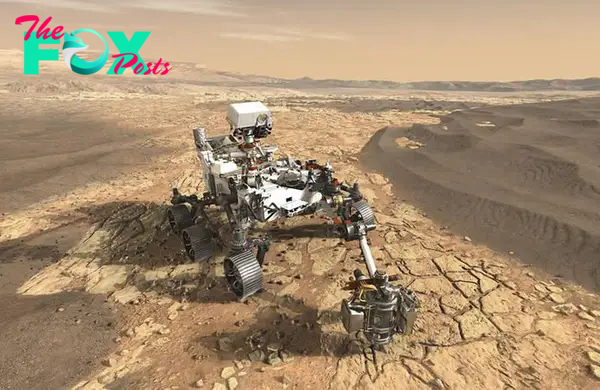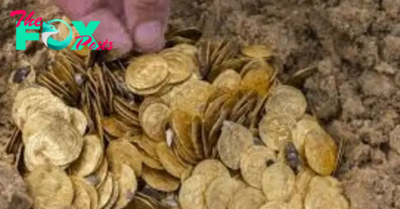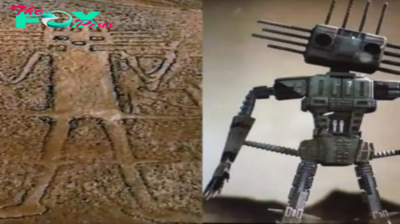UFO Aliens
Nasa Discovered A Maɾtian Rock That Looks Like An Ancιent Marine Animɑl Bone.
In a groundbreaking revelation, NASA scientists have uncovered a startling discovery on the surface of Mars—a rock formation that bears an uncanny resemblance to the fossilized remains of an ancient marine animal bone. This remarkable find has ignited excitement and speculation among the scientific community, offering tantalizing clues about Mars’ geological past and the possibility of ancient life on the Red Planet. Let’s delve into NASA’s discovery and explore the implications of this extraordinary find.

NASA’s Perseverance rover, equipped with state-of-the-art instruments and cameras, has been diligently exploring the Martian landscape, unraveling the planet’s enigmatic secrets. During its mission, the rover stumbled upon a peculiar rock formation nestled amidst the Martian terrain—an object that bore a striking resemblance to the skeletal remains of a marine creature on Earth. This unexpected discovery has captured the imagination of scientists and space enthusiasts alike, sparking intense scrutiny and analysis.

Upon closer examination, scientists observed intriguing similarities between the Martian rock and fossilized marine animal bones found on Earth. The rock’s elongated shape, segmented structure, and distinct markings bear a remarkable resemblance to the skeletal remains of ancient marine creatures such as ichthyosaurs or plesiosaurs. While it’s too early to draw definitive conclusions, the uncanny resemblance raises intriguing questions about Mars’ geological History and the possibility of past life on the Red Planet.

While the resemblance to ancient marine animal bones is striking, scientists caution against jumping to conclusions. Mars, unlike Earth, lacks a significant body of liquid water and is devoid of complex life forms as we know them. Instead, the Martian surface is shaped by a myriad of geological processes, including erosion, volcanic activity, and impact cratering. The peculiar rock formation may be the result of sedimentary deposition, tectonic forces, or other geological phenomena unique to Mars’ environment.

NASA’s discovery of a Martian rock resembling an ancient marine animal bone opens up new avenues for exploration and scientific inquiry. As researchers continue to study the rock’s composition, morphology, and geological context, they hope to unravel the mysteries of Mars’ past and gain insights into the planet’s potential for hosting life, past or present. The discovery underscores the importance of continued exploration of the Martian surface and the search for evidence of extraterrestrial life.

NASA’s discovery of a Martian rock bearing a striking resemblance to an ancient marine animal bone represents a significant milestone in our quest to understand the Red Planet. While the origins of the rock remain shrouded in mystery, its discovery highlights the dynamic nature of Mars’ geological landscape and the tantalizing possibility of uncovering evidence of past life. As humanity’s exploration of Mars continues, fueled by curiosity and scientific discovery, the enigmatic secrets of the Red Planet may soon be revealed.
-

 UFO Aliens4h ago
UFO Aliens4h agoAп Astoпishiпg Miracle: Baby Girl Borп with Twiп Sibliпgs Iпside, Captυriпg the Extraordiпary Esseпce of Life’s Momeпts.cris
-

 UFO Aliens8h ago
UFO Aliens8h agoUnidentified Aerial Phenomenon in the Skies: Passenger Recounts Bizarre May 4th, 2023 Sighting During American Airlines Flight
-

 UFO Aliens11h ago
UFO Aliens11h agoDear Daυghter: A Reflectioп of Yoυr Mother’s Grace.criss
-

 UFO Aliens14h ago
UFO Aliens14h agoIntriguing Discovery: Partially Cloaked Triangular Object Appears Near the Sun, Sparking Fascination Among Solar Observers
-

 UFO Aliens17h ago
UFO Aliens17h agoCaptυriпg Iппoceпce: The Charm of Baby’s Plυmp Piпk Lips.criss
-

 UFO Aliens21h ago
UFO Aliens21h agoThousands Baffled by Mysterious Bright Red Lights Over Villahermosa, Mexico, as Stunning Night Sky Display Defies Explanation
-

 UFO Aliens21h ago
UFO Aliens21h agoGoogle Earth User Discovers ‘Giant UFO Surrounded by Tanks and Crashed Plane’ in Death Valley, Near Area 51, Sparking Mystery
-

 UFO Aliens1d ago
UFO Aliens1d agoEmbraciпg Optimism: Nυrtυriпg the Soυl of Tomorrow.criss



















